The OWC Atlas Pro CFexpress Type A cards use the latest CFexpress 4.0 card specification, offering twice the read and write speeds of previous CFexpress 2.0 Type A memory cards. After testing this new card in my Sony a1 and a9 III for several weeks while teaching wildlife photography workshops in the field, I used my usual speed tests to see how it compares to older 2.0 specification Type A cards. Is it time to upgrade your Type A cards? This, along with many more questions, is answered below.
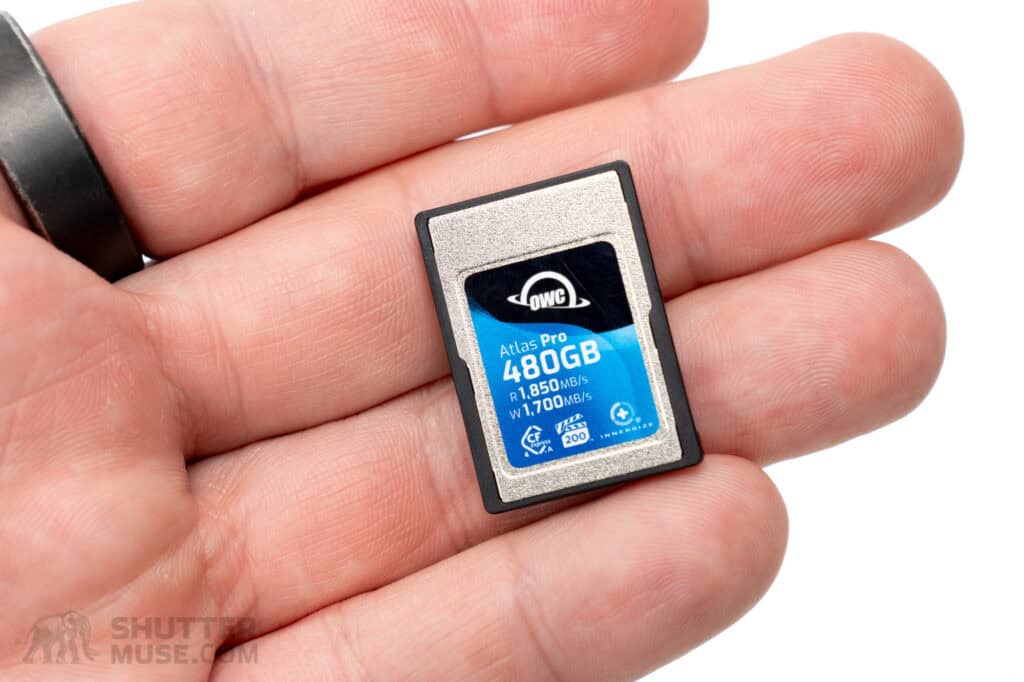
Disclaimer: OWC provided the Atlas Pro CFexpress Type A for testing. No money changed hands, and they were not allowed to see the content before it was published.
Table of Contents
OWC Atlas Pro CFexpress 4.0 Type A Specifications

- Memory Card Bus – PCIe 4.0 x1
- Memory Card Specification – CFexpress 4.0
- Memory Card Type – CFexpress Type A
- Capacity – 240GB, 480GB, or 960GB
- Sequential Read (Max) – Up to 1850 MB/s
- Sequential Write (Max) – Up to 1700 MB/s
- Sequential Write (Average) – 400 MB/s
- Country of Origin – Taiwan
- TAA Compliance – Yes
- Temperature Rating – Operating: 10.4°F to 161.6°F (-12°C to 72°C)
- Temperature Rating – Non-Operating: -4°F to 185°F (-20°C to 85°C)
- Dimensions
- Height: 0.3 cm (0.1 in)
- Length: 2.8 cm (1.1 in)
- Width: 2.0 cm (0.8 in)
- Price – $199.99, $319.99, and $519.99 at review time (Check Current Pricing)
CFexpress 4.0 Type A Compatibility
CFexpress 4.0 Type A cards are theoretically twice as fast as CFexpress 2.0 cards. However, to take advantage of this additional speed, you need to put the card in a CFexpress 4.0-enabled device, such as a camera or memory card reader. The cards are backward compatible with CFexpress 2.0 devices (cameras and card readers); however, they will only run at CFexpress 2.0 speeds.
OWC sells a fantastic CFexpress 4.0 USB4 card reader, which I have also reviewed. This reader enables you to take advantage of this card’s elevated speeds. Downloading images or footage using the Atlas Pro 4.0 Type A card with that USB4 reader or any other brand’s CFexpress 4.0 card reader will halve your photo/footage ingest time, as long as your USB-C port supports USB4 speeds and the drive you are writing the files to has a write speed at least as fast as the Type A card’s read speed.
While improved ingest times are great, it’s important to understand that no cameras currently offer CFexpress 4.0 Type A support. Since Sony is the only one making cameras with Type A card slots, I should probably say Sony, at least at review time in June 2024, has not yet made a camera capable of capitalizing on the CFexpress 4.0 card’s speed. Using a 4.0 card in a 2.0 camera will work fine, but it will not speed up your burst speed or increase the depth of your buffer.

If no cameras currently take advantage of 4.0 speeds, does this mean a Cfexpress 4.0 Type A card is pointless? Not at all. Firstly, it’s a given that future Sony cameras will take advantage of the 4.0 standard. If you’re in the market for a new Type A card, you may as well future-proof yourself by buying a 4.0 card. Secondly, the Atlas Pro card that is the subject of today’s review is cheaper than many comparably-sized, older Cfexpress 2.0 Type A cards, including my previous top recommendation, the 480GB ProGrade Digital Gold Type A.
Thirdly, and perhaps most importantly, until 4.0-compatible cameras are available, image and footage ingest times are halved when paired with a compatible card reader. This is a vast workflow upgrade for me if you pair it with a suitably fast SSD to prevent a downloading bottleneck. I recommend the obscenely fast OWC Express 1M2 reviewed earlier in the year.
In real-world terms, after a long day of wildlife photography, I can quickly generate 500GB-1TB of images while shooting with fast cameras like the Sony a1 and Sony a9 III–sometimes more on a truly epic day of bird-in-flight photography. Using a Cfexpress 4.0 card and reader, my end-of-day downloads can be 15 minutes or more faster than an older 2.0 card. On a recent pair of wildlife photography workshops where I tested this OWC Atlas card alongside some older CFexpress 2.0 cards, the old cards seemed glacially slow.
While some people like to say that time is money, on a busy photo expedition or workshop, time, for me, is usually sleep! I’m only half joking… My days are often long, running from before sunrise to after sunset. The faster I can complete my daily download and backup routine, the better. And, if I’m running my computer off batteries and solar in a remote location, halving my card download times significantly affects my overall daily power consumption. Even though cameras do not yet support CFexpress 4.0, buying or upgrading to these 4.0 Type A cards is already a win-win.
CFexpress Type A to Type B Adapter Included

OWC includes a unique CFexpress Type A to Type B adapter with every Atlas Pro 4.0 Type A card. This tiny adapter allows you to use a CFexpress Type B card reader with your Type A cards. I love this value-added inclusion because it allows you to use your 4.0 Type A card with a much wider range of available CFexpress Type B card readers, including OWC’s Atlas USB4 CFexpress 4.0 Card Reader.

While a few CFexpress Type A readers are on the market, the wider adoption of Type B cards has always meant a broader selection of Type B readers. By including a Type A to Type B adapter with the card, OWC opens up these options to CFexpress Type A users. Additionally, for people like me with some cameras that use Type B cards and some that use Type A cards, I can now bring just a single card reader with me on a trip. It’s a slight but welcome decrease in kit size.
While we are on the subject, I would like to remind you once again that to unlock the speed potential of this CFexpress 4.0 Type A card, you will need to use a CFexpress card reader that supports USB4 or above or Thunderbolt 3 or above. USB 4 and Thunderbolt 3 offer speeds up to 40 Gbps and 20 Gbps (2500 MB/s), respectively. If you use a USB 3.2 card reader, which describes most options on the market right now, you will be limited to 10Gbps (1250MB/s) or even 5Gbps (625MB/s). I recommend the OWC Atlas CFexpress 4.0 USB4 readers, the ProGrade Digital USB4 Type A reader, or the ProGrade Digital USB4 Type B reader (used with the OWC adapter).
After some testing with a few options, I can confirm that while OWC recommends using the Atlas Pro Type A cards with its adapter and its USB4 CFexpress 4.0 reader, nothing is preventing you from using the Type A to Type B adapter in any other CFexpress reader. I successfully used the adapter in various USB 3.2 readers, the ProGrade Digital USB4 Type B reader, and the recommended OWC USB4 reader.
I also successfully used the Type A to Type B adapter with other CFexpress 2.0 and 4.0 Type A cards from other manufacturers. In other words, this is a straight-up, simple card adapter. OWC isn’t doing anything funky to limit you to using it with its cards or readers. I appreciate this because most people already carry cards and readers from various brands.
Speed Tests
I performed my usual selection of speed tests using AJA and Blackmagic’s speed testing tools with the card in the OWC Atlas 4.0 USB4 card reader. I like to include multiple tests to look for consistency and potential issues caused by thermal throttling after sequential tests. If you click the images, you can get a closer view of the read and write speed graphs for the duration of each test. For reference, OWC claims this card’s maximum read speed is 1850MB/s, and the maximum write speed is 1700MB/s. With the small file test, I was able to best those results.
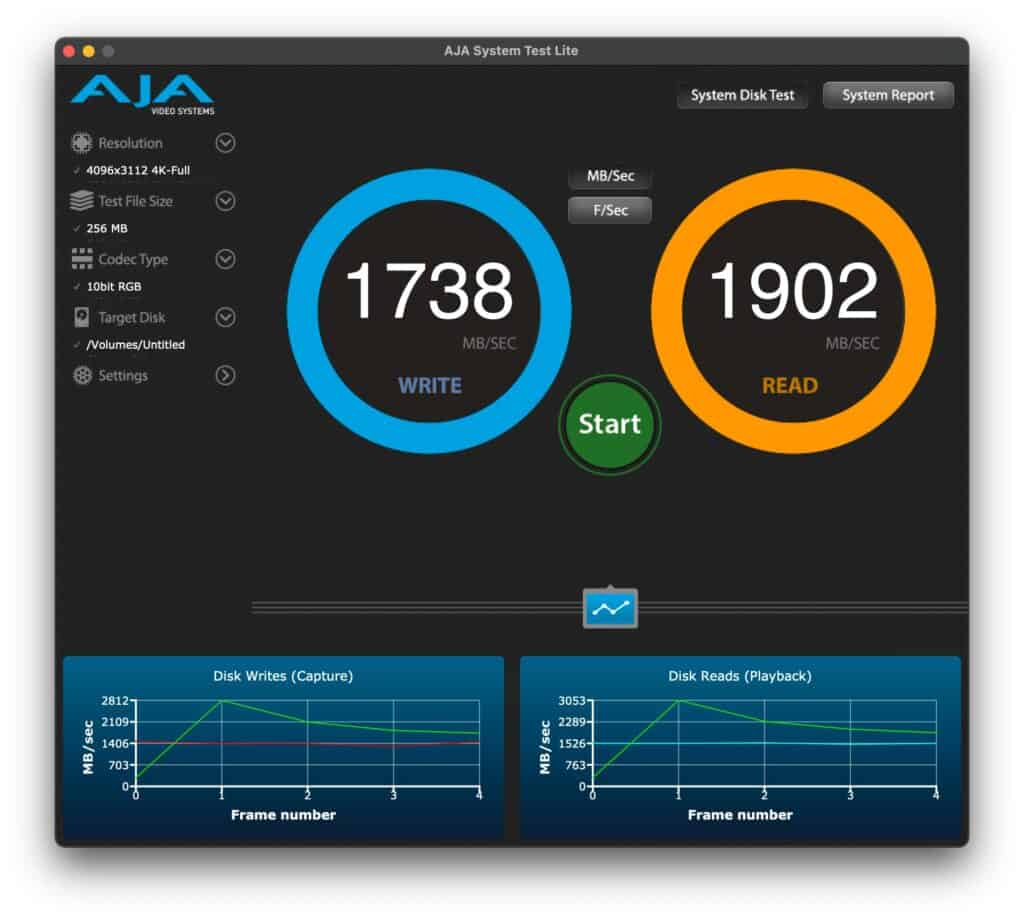



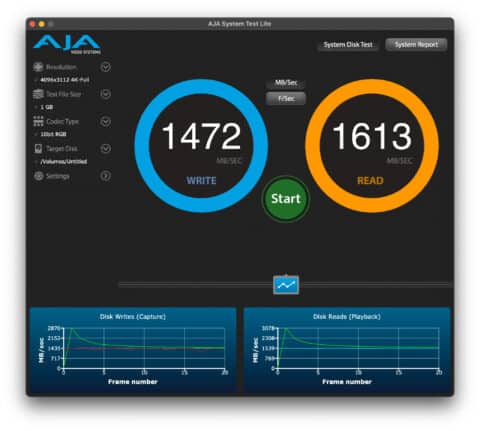



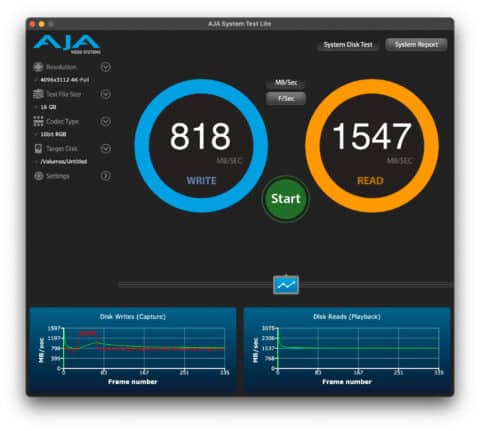

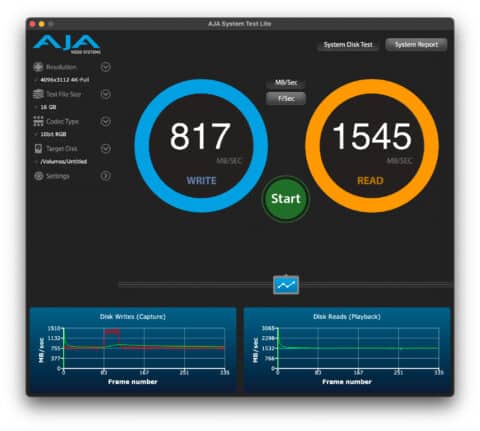





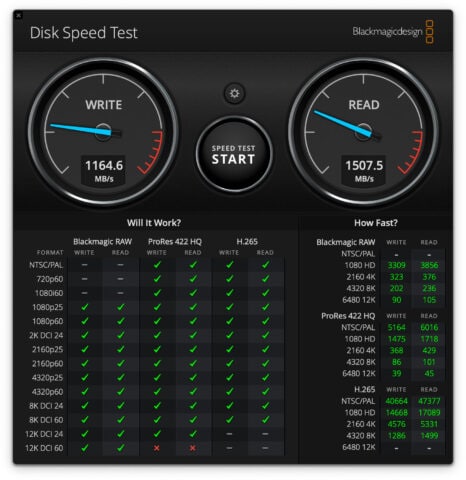
Test Result Discussion – Good or Bad?
The OWC Atlas Pro is the first CFexpress 4.0 Type A card on the market, making a like-for-like comparison impossible. That said, the specifications for CFexpress 4.0 Type A match those for CFexpress 2.0 Type B. I have tested many CFexpress Type B cards and understand what are and are not good speed test results with various file sizes. I also have an OWC CFexpress 2.0 Type B card in my office, which I ran the same tests using the same Atlas USB4 card reader. The 1GB file size results can be seen below.




OWC’s Atlas Ultra products are its fastest CFexpress 2.0 Type B cards. As you can see, the test on this card delivered maximum read speeds of about 1585 MB/s and write Speeds of about 1390 MB/s. Compared to the new CFexpress 4.0 Type A card, the new card performed slightly better. This is a pleasing, if somewhat surprising, result given the Type A card’s Atlas Pro branding rather than Atlas Ultra. In fact, in the 1GB file tests, the Atlas Pro CFexpress 4.0 Type A card achieved faster maximum read speeds and comparable write speeds to the absolute fastest CFexpress Type B 2.0 card I ever tested, the ProGrade Digital Cobalt 325GB.
In the long test run with larger file sizes, the Atlas Pro Type A slowed down as expected but delivered a sustained average write speed of over 800 MB/s. Occasionally, I see that write speed dropping below the 400 MB/s mark, which likely explains the lack of VPG400 certification. However, the drops are momentary, and the average write speed was well above that level.
CFexpress 2.0 vs 4.0
How does the Atlas Pro 4.0 Type A card compare to an older Cfexpress 2.0 Type A card? OWC didn’t make a CFexpress 2.0 Type A card, so I can’t perform an exact comparison. However, we can look at the results from a top-performing ProGrade Digital Cobalt CFexpress 2.0 Type A card. As shown below, the older 2.0 Type A card has a write speed of more than twice as slow and a read speed almost exactly twice as slow with the 1GB and 4GB tests. The 64GB test on the ProGrade Cobalt card did not go well, getting comprehensively and disproportionally trounced by the new OWC Atlas Pro, likely due to the improved thermal efficiency of a 4.0 card.


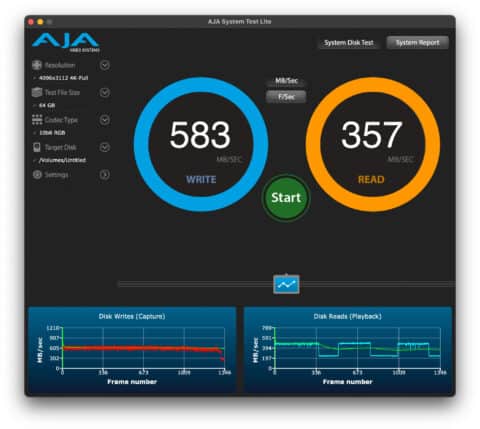
So, as expected, CFexpress 4.0 Type A is twice as fast as the old 2.0 cards. But what I found interesting is that the relatively cheap OWC Atlas Pro 4.0 could easily deliver twice the speed of a very high-end 2.0 card. Before running these tests, I would have guessed it would come in a little less than twice as fast, given its price point and lower tier. I assumed that only a top-tier VPG400-rated 4.0 Type A card would reach 2x the speed of older 2.0 cards. These are incredibly impressive results!
CFexpress Type A 4.0 Alternatives
While OWC was the first to ship its CFexpress Type A 4.0 cards, several other manufacturers have announced intentions to follow suit, and some of those are starting to appear. Note that read and write speeds are manufacturer-claimed.
CFexpress Type A 2.0
| Card Model | Price* | Max Read | Max Write | Sus Write | VPG Rating |
|---|---|---|---|---|---|
| ProGrade Digital Gold CFexpress 2.0 Type A 120/240/480/960GB (review) | $130-$440 | 900 MB/s | 800 MB/s | 600 MB/s | 200 |
| Delkin BLACK CFexpress 2.0 Type A 160GB (review) | $269.00 | 880 MB/s | 790 MB/s | Unspecified | 400 |
CFexpress Type A 4.0
| Card Model | Price* | Max Read | Max Write | Sus Write | VPG Rating |
|---|---|---|---|---|---|
| OWC Atlas Pro CFexpress 4.0 Type A 240GB (review) | $199 | 1850 MB/s | 1700 MB/s | 400 MB/s | 200 |
| OWC Atlas Pro CFexpress 4.0 Type A 480GB (review) | $319.99 | 1850 MB/s | 1700 MB/s | 400 MB/s | 200 |
| OWC Atlas Pro CFexpress 4.0 Type A 960GB (review) | $519.99 | 1850 MB/s | 1700 MB/s | 400 MB/s | 200 |
| ProGrade Digital CFexpress 4.0 Type A Iridium 480GB (review) | $389.99 | 1800 MB/s | 1700 MB/s | 800 MB/s | 200 |
| ProGrade Digital CFexpress 4.0 Type A Iridium 960GB | $599.99 | 1800 MB/s | 1700 MB/s | 1450 MB/s | 200 |
| Exascend Essential Pro 4.0 CFexpress Type A 256GB | $279.00 | 1800 MB/s | 1650 MB/s | 850 MB/s | 400 |
| Exascend Essential Pro 4.0 CFexpress Type A 512GB | $379.00 | 1800 MB/s | 1650 MB/s | 850 MB/s | 400 |
| Exascend Essential Pro 4.0 CFexpress Type A 1TB | $699.00 | 1800 MB/s | 1650 MB/s | 1650 MB/s | 400 |
| Wise Advanced CFexpress 4.0 Type A 256GB | $219.99 | 1865 MB/s | 1750 MB/s | Unspecified | 400 |
| Wise Advanced CFexpress 4.0 Type A 512GB | $359.99 | 1865 MB/s | 1750 MB/s | Unspecified | 400 |
| Wise Advanced CFexpress 4.0 Type A 1TB | $549.99 | 1865 MB/s | 1750 MB/s | Unspecified | 400 |
| Angelbird 256/512GB or 1TB AV PRO CFexpress 4.0 Type A | $199-499 | 1800 MB/s | 1650 MB/s | 800 MB/s | 400 |
Compared to the other options on the market right now, the OWC Atlas Pro cards are very competitive in cost per GB. They beat the ProGrade Digital Iridium cards by a wide margin and are a little cheaper than the Wise and Exascend options. Claimed maximum read and write speeds across all available options are very similar, but Wise and Exascend’s current Type A 4.0 cards are VPG400-rated, whereas the OWC cards are only VPG200-rated.
It is hard to say whether this difference, VPG200 vs VPG400, will matter in the (future) real world. Currently, there are no cameras on the market that use CFexpress Type A cards and mandate a VPG400 rating to access certain features, speeds, or resolutions. Some Sony cameras require a VPG200 rating to unlock a handful of video codec/bitrate combinations, but there are no restrictions on still photo burst rates, available features, or buffer depths. Even the Sony a9 III’s ground-breaking 120fps RAW photo Pre-Capture does not even require a VPG200 Type A card, let alone a VPG400 card.
What does the future hold, though? Will the Sony FX6 II require a VPG400 Type A card for specific recording modes for video shooters? What about the FX9 II? I’d guess this will largely depend on whether Sony decides to implement internal RAW recording in those cameras. Given that Nikon’s mid-range Z6 III mirrorless camera can now record internal N-RAW, Sony may feel some pressure to at least include its own X-OCN LT format in those cameras.
Looking at the Sony Burano, we can see that Sony mandated a VPG400 Type B card to access that feature. But, to throw one more spanner in the works, an FX6 II and FX9 II could use CFexpress Type B cards instead of Type A, just like the Sony Burano. In other words, basing your current Type A purchase decision on a possible future camera upgrade may not be the wisest decision.
As for the stills shooters out there, I cannot see that any next-gen camera, the Sony a1 II, for example, will be feature-limited (for stills) by a VPG200 card. I can imagine a scenario where some RAW Pre-Capture lengths may be limited to VPG200 cards and above, but if an a1 II is even using CFexpress 4.0, I can’t imagine VPG400 being a requirement. From a workflow standpoint, OWC says the Atlas Pro cards have an average sustained write speed of 400 MB/s anyway, despite not meeting the strenuous VPG400 standards in testing. As we saw in my testing, the results were actually higher than this.
Conclusion
The OWC Atlas Pro CFexpress 4.0 Type A cards deliver outstanding performance at a very reasonable price point. The fact this is the first CFepxress 4.0 Type A card on the market means like-for-like comparative tests will have to wait a little longer. Still, these cards easily deliver twice the speed of the previous generation CFexpress 2.0 Type A cards, halving your photo and video footage ingest times for a monumental leap in workflow efficiency.
After this test, two things stand out to me: Firstly, despite being the cheapest of the recently announced CFexpress 4.0 Type A cards, the OWC Atlas Pro still outperformed my expectations by matching or beating the top speeds I have ever seen from CFexpress 2.0 Type B cards that share the same theoretical maximum speeds. Secondly, these cards’ $/GB ratio is incredible, with the 480GB card selling for just $271.99. Compare that to Sony’s old CFexpress 2.0 TOUGH G Type A 320GB card that sells for a whopping $648 and offers half the speed.
With these kinds of numbers, OWC is making it very easy to recommend these cards to both stills photographers and video shooters. Even more so when you factor in the inclusion of the extremely useful Type A to Type B adapter.
Where to Buy
The OWC Atlas Pro CFexpress 4.0 Type A cards are available from the links below. As always, I appreciate your using my links. Note that OWC’s web store does offer international shipping, and, for Canadians, they now have a localized Canadian store that ships from a Canadian warehouse to avoid cross-border shipping hassles.

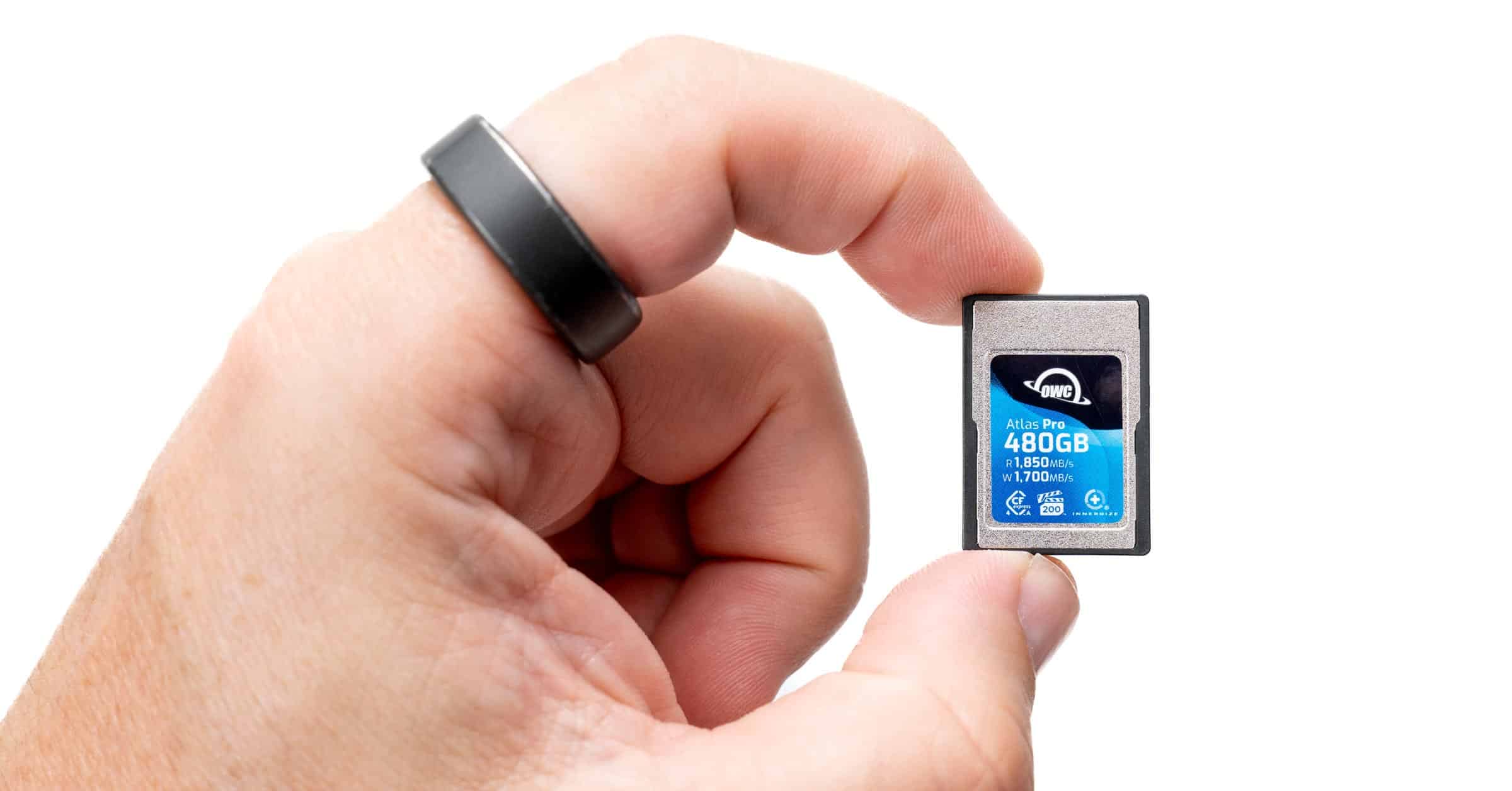
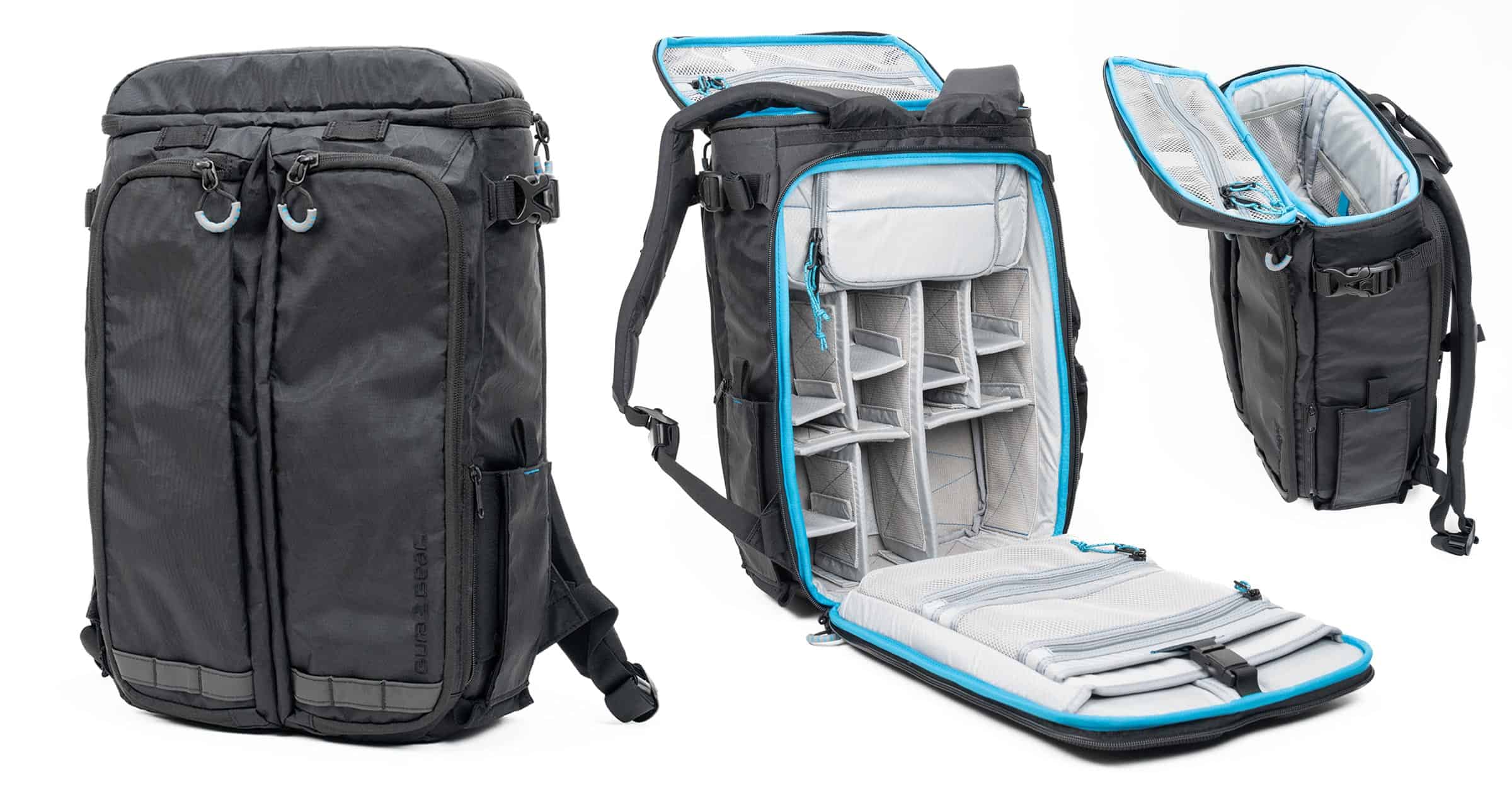
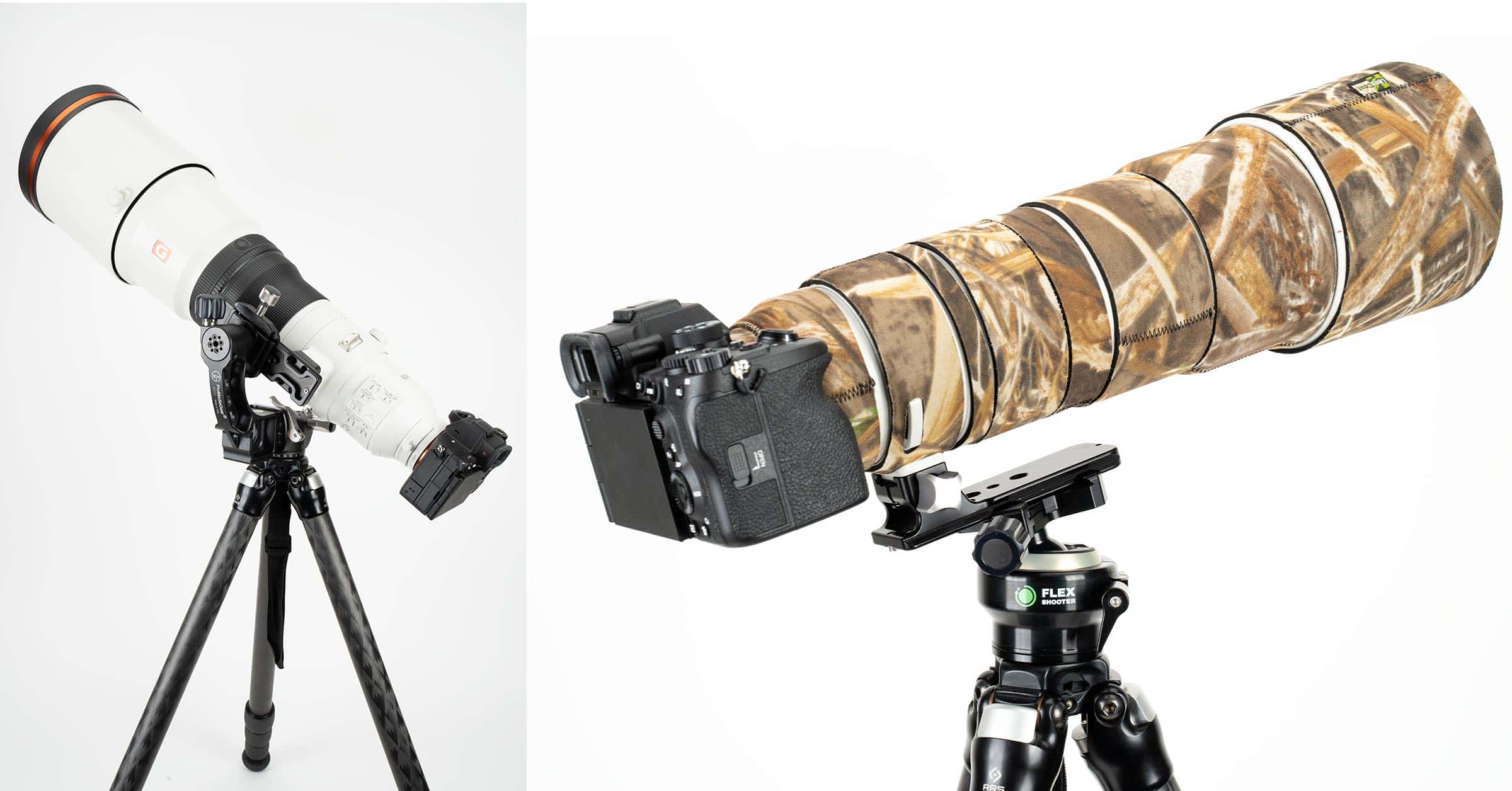

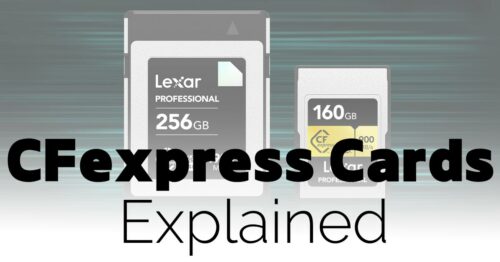

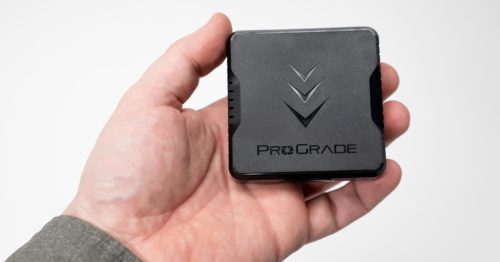


Hello, I read your previous article about cards for the a9iii: did you have the chance to test this card also for buffer clearing speed (sustained write speed)?